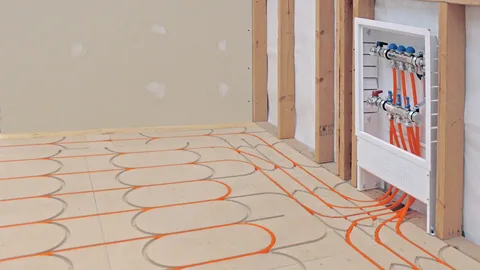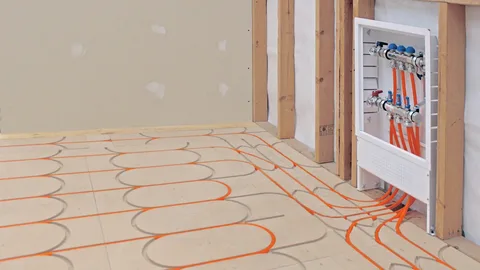Embracing radiant heating systems transforms home comfort with efficient warmth distributed through floors, walls, or ceilings. Home radiant heating systems operate silently, avoiding the air quality issues of traditional heating methods while providing consistent, gentle heat. Radiant heating offers a cozy living environment by eliminating cold spots and reducing energy consumption compared to forced-air systems. Choosing the right system ensures tailored heating solutions for modern homes, enhancing comfort without compromising energy efficiency or indoor air quality.
Benefits of Radiant Heating Systems
Imagine stepping into a warm and cozy home where the heat envelops you like a gentle hug, banishing the chill of the outside world. This is the magic of radiant heating systems, which offer many benefits, making them a superior choice for homeowners seeking comfort, efficiency, and cost-effectiveness. One of the most significant advantages of radiant heating is its ability to provide consistent, even heat, eliminating the cold spots and drafts common with traditional forced-air systems.
Radiant heating systems are extremely efficient, as they heat objects and people directly rather than wasting energy on heating the air. This translates to significant cost savings over time, making it a smart investment for homeowners. Furthermore, radiant heating systems are healthier, as they don’t circulate allergens and dust particles like traditional systems do. They are also quieter, more durable, and require less maintenance, making them a low-fuss, high-reward solution for homeowners seeking a comfortable and efficient heating solution.
Outdoor Radiant Heater: Essential Insights
Outdoor radiant-heaters offer a unique and efficient way to extend your outdoor living space, even in the chilliest temperatures. Imagine enjoying your patio, deck, or pool area well into the fall and winter months without the constraint of cold weather. With an outdoor radiant heater, you can do just that. These innovative systems use infrared radiation to warm objects and people rather than heating the air, resulting in more efficient and cost-effective to heat your outdoor space.
Plus, they’re often more energy-efficient than traditional outdoor heating sources, such as fire pits or space heaters. Outdoor radiant-heaters come in various styles, including wall-mounted, ceiling-mounted, and freestanding units, making it easy to find one that fits your specific needs and outdoor layout. Whether you want to extend your outdoor living season or enjoy a warm and cozy outdoor space on a chilly evening, an outdoor radiant-heater is an excellent choice.
Types of Radiant Heating Systems
Radiant heating systems come in various forms, each with unique advantages and suitability for different homes and climates. One of the most popular types is the Hydronic Radiant Floor System, which involves the installation of tubes under the floor that circulate warm water to heat the space. Another option is the Electric Radiant Floor System, which uses electric mats or cables to warm the floor. This type of system is often preferred for smaller areas, such as bathrooms or kitchens, and is relatively easy to install.
Radiant Panel Systems are also available for those who prefer a more traditional approach, which involves installing ceiling panels that warm the space through radiation. Finally, there are also hybrid radiant heating systems, which combine different types of radiant heating to provide a customized solution for homeowners. Regardless of the type chosen, radiant heating systems offer a comfortable, efficient, and cost-effective way to heat your home.
 Energy Efficiency of Electric Radiator Heater
Energy Efficiency of Electric Radiator Heater
One of the most significant advantages of electric radiator-heaters is their exceptional energy efficiency. Unlike traditional central heating systems that waste energy by heating entire homes, electric radiator-heaters directly warm the spaces and objects they come into contact with, significantly reducing energy consumption. This means you can enjoy a warm, cozy living space without breaking the bank.
Electric radiator-heaters are designed to convert almost all the electrical energy they consume into usable heat, minimizing heat loss and ensuring that your home is heated efficiently. With an electric radiator heater, you can save up to 30% on your energy bills compared to traditional heating systems, making it a cost-effective and environmentally friendly solution for your home heating needs.
Installation and Maintenance Tips
Installing and maintaining a home radiant heating system requires careful planning and attention to detail to ensure optimal performance and longevity. Here are essential tips for both installation and maintenance:
Installation Tips
- Professional Installation: Hire experienced professionals familiar with radiant heating systems. Proper installation is crucial for efficient operation and avoiding potential issues.
- Floor Preparation: Ensure the subfloor is clean, level, and adequately insulated before installation. Adequate insulation helps maximize energy efficiency and prevents heat loss.
- System Layout: Plan the layout of heating elements or tubing carefully, considering the size and shape of each room. Optimize placement to achieve even heat distribution and minimize material waste.
- Compatible Flooring: Choose materials compatible with radiant heating, such as tile, stone, or laminate. Consult with manufacturers to ensure compatibility and performance.
Maintenance Tips
- Regular Inspections: Schedule routine inspections to check for leaks, damage, or efficiency issues. Early detection can prevent costly repairs and ensure continuous operation.
- Annual Servicing: Arrange for yearly servicing by a qualified technician to inspect components, test controls, and ensure proper system operation. This helps identify potential issues early and extends the system’s lifespan.
- Water Quality: If using a hydronic system, monitor water quality and maintain proper chemical balance to prevent corrosion and sediment buildup in pipes and boiler units.
- Manufacturer Guidelines: Follow manufacturer guidelines for maintenance tasks and schedule recommended servicing intervals. Adhering to these guidelines ensures warranty compliance and preserves system performance over time.
Health Benefits of Using a Radiator Heater
A radiator heater offers several health benefits, enhancing indoor comfort and well-being. These heaters operate without circulating air, which helps reduce the circulation of allergens, dust particles, and other airborne pollutants that can aggravate respiratory conditions such as asthma and allergies.
Radiator-heaters create a more comfortable environment without drying out the air by emitting radiant heat directly into the room, unlike forced-air heating systems. Radiator-heaters provide consistent and even heat distribution throughout the space, minimizing temperature fluctuations that can lead to discomfort and potential health issues such as headaches or fatigue.
Their gentle warmth promotes relaxation and can soothe muscle tension, making them particularly beneficial in living areas and bedrooms. Furthermore, radiator-heaters are generally quieter than other heating systems, contributing to a more peaceful indoor environment conducive to restful sleep and overall relaxation. Their operation does not disturb daily activities or conversations, enhancing the overall comfort and usability of the living space.
Choosing the Right Radiant Heating System for Your Home
Choosing the right radiant heating system for your home involves considering several key factors to ensure optimal comfort and efficiency. Here are some essential tips to guide your decision:
System Type
Decide between hydronic (water-based) and electric radiant heating systems. Hydronic systems are ideal for larger areas and new constructions due to their efficiency and even heat distribution. Electric systems are easier to install in existing homes and provide quicker response times, but they may cost more to operate over the long term.
Flooring Compatibility
Consider the type of flooring in your home. Due to their thermal conductivity, radiant heating systems work well under tile, stone, and concrete. For wood or carpeted floors, choose systems specifically designed to accommodate these materials.
Heating Capacity
Calculate the heating load required for each room or zone to determine the appropriate system size. This involves considering room size, insulation levels, and local climate conditions.
Zoning Options
Opt for systems that offer zoning capabilities. These allow you to independently control heating levels in different areas of your home. Zoning enhances energy efficiency by directing heat only where and when needed.
Installation and Maintenance
Ensure the system is installed by qualified professionals familiar with radiant heating technology. Proper installation is crucial for efficiency and longevity. Also, choose systems requiring minimal maintenance and reliable warranties to protect your investment.
Factors Influencing the Radiant Heating System Cost
Several factors influence radiant heating system cost, making it essential to consider various aspects when planning installation. The type of radiant heating system chosen significantly impacts overall expenses. Hydronic systems use heated water circulated through tubing and are more expensive due to installation complexity and materials. In contrast, electric radiant systems, utilizing electric cables or mats beneath flooring, offer a more straightforward installation process and lower upfront costs.
The size of the area to be heated directly affects the cost of the radiant heating system. Larger spaces require more heating elements or longer tubing runs, increasing material and labour expenses. Additionally, the type of flooring or surface where the system will be installed plays a role. Installing radiant heating beneath tile or stone generally involves more labour and materials than under carpet or laminate flooring.
Moreover, the complexity of the installation process influences the cost of a radiant heating system. Retrofitting an existing home with radiant heating may require additional labour for accessing floors or walls, compared to installing during new construction. Factors such as insulation quality and local labour rates can impact total expenses. By evaluating these variables and consulting with professionals, homeowners can effectively plan for radiant-heating system costs that align with their budget and heating needs.
Conclusion
Radiant heating systems offer unparalleled comfort and efficiency, quietly providing warmth by radiating heat directly from the floor, walls, or ceiling. They eliminate the inefficiencies and air quality concerns associated with forced-air systems, enhancing indoor comfort while reducing energy consumption. Homeowners can enjoy consistent warmth and lower heating costs by choosing the right system and ensuring proper installation and maintenance. Radiant heating’s ability to distribute heat evenly without drafts or noise makes it a preferred option for modern homes, aligning comfort with sustainability in heating technology. Its growing popularity underscores its effectiveness in providing a cozy, energy-efficient living environment.
FAQs
How do home radiant-heating systems work?
Radiant heating systems emit infrared radiation that heats objects and surfaces in the room, radiating heat back into the space. This heat transfer method creates a more even and comfortable indoor environment than traditional forced-air systems.
What types of home radiant-heating systems are available?
Two types of home radiant-heating systems are primarily hydronic (water-based) and electric. Hydronic systems use heated water circulated through tubing under the floor, while electric systems use electric cables or mats installed beneath flooring materials.
What are the advantages of using home radiant heating systems?
Home radiant heating systems offer several advantages, including energy efficiency, reduced air circulation of allergens and dust, quiet operation, and zoning capabilities for personalized comfort in different home areas.
Where can home radiant-heating systems be installed?
Home radiant-heating systems can be installed in various areas, including new constructions and renovations. Depending on the system type and home layout, they are commonly installed under tile, stone, laminate, or engineered wood flooring and in walls or ceilings.
Are home radiant-heating systems suitable for all climates?
Yes, home radiant-heating systems are suitable for all climates. They can efficiently heat homes in cold climates by providing consistent warmth without the drafts associated with forced-air systems. Proper insulation and system design ensure effective operation in warm and cold regions.
| cme Blog Spot |
| Blogs Rain |
| Cme Blog Spot |
| Garcias Blogs |
| Yyc Blogs |
| Guiade Blogs |
| Blogs-Hunt |
| Impact-Blog |
| Smarty Blogs |
| Ed Blog |
| Mo Blogs |
| Blogs Em |
| Blogs T |
| Related Business Listings |
| Contact Directory |
| Local Business Profiles |



